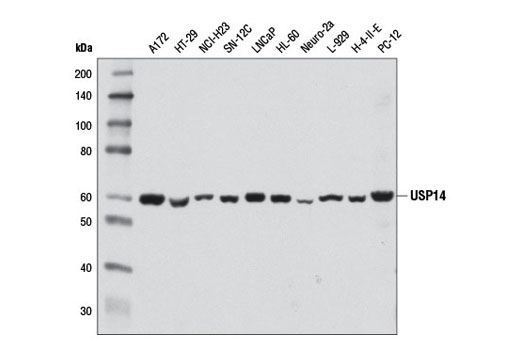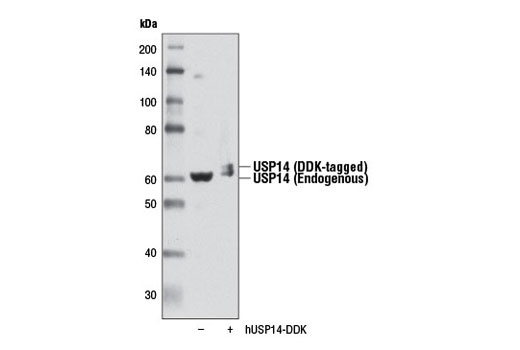WB
H M R
Endogenous
60
Rabbit
#P54578
9097
Product Information
Product Usage Information
| Application | Dilution |
|---|---|
| Western Blotting | 1:1000 |
Storage
Specificity / Sensitivity
Species Reactivity:
Human, Mouse, Rat
Species predicted to react based on 100% sequence homology
The antigen sequence used to produce this antibody shares
100% sequence homology with the species listed here, but
reactivity has not been tested or confirmed to work by CST.
Use of this product with these species is not covered under
our
Product Performance Guarantee.
Bovine, Dog, Pig, Horse
Source / Purification
Polyclonal antibodies are produced by immunizing animals with a synthetic peptide corresponding to residues near the carboxy terminus of human USP14 protein. Antibodies are purified by protein A and peptide affinity chromatography.
Background
Ubiquitinating enzymes (UBEs) catalyze protein ubiquitination, a reversible process countered by deubiquitinating enzyme (DUB) action (1,2). Five DUB subfamilies are recognized, including the USP, UCH, OTU, MJD, and JAMM enzymes. In humans, there are three proteasomal DUBs: PSMD14 (POH1/RPN11), UCH37 (UCH-L5), and Ubiquitin-Specific Protease 14, which is also known as the 60 kDa subunit of tRNA-guanine transglycosylase (USP14/TGT60 kDa). USP14 is recruited to the proteasome through its reversible association with the PSMD2 (S2/hRPN1) subunit of the 19S regulatory particle. Whereas PSMD14 appears to promote substrate degradation (3,4), USP14 is thought to antagonize substrate degradation (5-8). While the underlying mechanism for the opposing roles of these two proteasomal DUBs is still uncertain, it is thought that USP14 removes ubiquitin from substrate upon docking of the substrate with the 26S proteasome. Furthermore, USP14 trims ubiquitin residues from the distal end of the polyubiquitin chain, thus decreasing the affinity of the chain for the ubiquitin receptors of the proteasome, and allowing for enhanced substrate stability (6,9,10). Studies have elucidated a physiologic role for USP14 in regulating synaptic activity in mammals (11). Research studies have shown that targeting this activity with small molecule inhibitors has potential benefits for the treatment of neurodegenerative diseases and cancer (5,12).
- Nijman, S.M. et al. (2005) Cell 123, 773-86.
- Nalepa, G. et al. (2006) Nat Rev Drug Discov 5, 596-613.
- Verma, R. et al. (2002) Science 298, 611-5.
- Yao, T. and Cohen, R.E. (2002) Nature 419, 403-7.
- Lee, B.H. et al. (2010) Nature 467, 179-84.
- Lam, Y.A. et al. (1997) Nature 385, 737-40.
- Koulich, E. et al. (2008) Mol Biol Cell 19, 1072-82.
- Jacobson, A.D. et al. (2009) J Biol Chem 284, 35485-94.
- Hanna, J. et al. (2006) Cell 127, 99-111.
- Thrower, J.S. et al. (2000) EMBO J 19, 94-102.
- Wilson, S.M. et al. (2002) Nat Genet 32, 420-5.
- D'Arcy, P. et al. (2011) Nat Med, Epub ahead of print.
Species Reactivity
Species reactivity is determined by testing in at least one approved application (e.g., western blot).
Western Blot Buffer
IMPORTANT: For western blots, incubate membrane with diluted primary antibody in 5% w/v BSA, 1X TBS, 0.1% Tween® 20 at 4°C with gentle shaking, overnight.
Applications Key
WB: Western Blotting
Cross-Reactivity Key
H: human M: mouse R: rat Hm: hamster Mk: monkey Vir: virus Mi: mink C: chicken Dm: D. melanogaster X: Xenopus Z: zebrafish B: bovine Dg: dog Pg: pig Sc: S. cerevisiae Ce: C. elegans Hr: horse GP: Guinea Pig Rab: rabbit All: all species expected
Trademarks and Patents
Limited Uses
Except as otherwise expressly agreed in a writing signed by a legally authorized representative of CST, the following terms apply to Products provided by CST, its affiliates or its distributors. Any Customer's terms and conditions that are in addition to, or different from, those contained herein, unless separately accepted in writing by a legally authorized representative of CST, are rejected and are of no force or effect.
Products are labeled with For Research Use Only or a similar labeling statement and have not been approved, cleared, or licensed by the FDA or other regulatory foreign or domestic entity, for any purpose. Customer shall not use any Product for any diagnostic or therapeutic purpose, or otherwise in any manner that conflicts with its labeling statement. Products sold or licensed by CST are provided for Customer as the end-user and solely for research and development uses. Any use of Product for diagnostic, prophylactic or therapeutic purposes, or any purchase of Product for resale (alone or as a component) or other commercial purpose, requires a separate license from CST. Customer shall (a) not sell, license, loan, donate or otherwise transfer or make available any Product to any third party, whether alone or in combination with other materials, or use the Products to manufacture any commercial products, (b) not copy, modify, reverse engineer, decompile, disassemble or otherwise attempt to discover the underlying structure or technology of the Products, or use the Products for the purpose of developing any products or services that would compete with CST products or services, (c) not alter or remove from the Products any trademarks, trade names, logos, patent or copyright notices or markings, (d) use the Products solely in accordance with CST Product Terms of Sale and any applicable documentation, and (e) comply with any license, terms of service or similar agreement with respect to any third party products or services used by Customer in connection with the Products.

